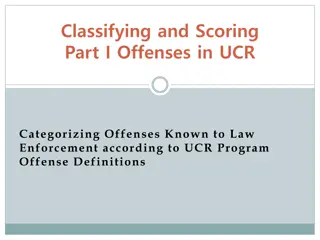Updates on UCR Group Medium Energy and STAR Forward Upgrade
UCR Group has updates on faculty, postdocs, grad students, and ongoing projects in Medium Energy and Heavy-Ion domains. The STAR Forward Upgrade focuses on Calorimeter System R&D for EIC Detector. TMDs research at STAR is advancing with data on higher x values and Q2 at 100 GeV2. Initial State of Nuclei research aims to understand heavy nuclei's initial state for RHIC and LHC programs. Opportunities at pA@RHIC and various experiments offer insights into nuclear effects and saturation regions.
Download Presentation

Please find below an Image/Link to download the presentation.
The content on the website is provided AS IS for your information and personal use only. It may not be sold, licensed, or shared on other websites without obtaining consent from the author. Download presentation by click this link. If you encounter any issues during the download, it is possible that the publisher has removed the file from their server.
E N D
Presentation Transcript
UCR Group Updates UCR Group Updates Medium Energy: Faculty: Ken Barish, (+ Miguel 1/1/2020) Postdocs: Chong Kim, Latif Kabir, +1 PD (Miguel s) Grad students: William Baker, Malia Chevalier, David Kapukchyan, Xilin Xilin Liang Liang, + 1-2 students (Miguel s). Heavy-Ion: Faculty: Rich Seto Postdocs: Yang Wu Grad students: Erik Loyd, Camron Racz, Liankun Zou, Ding Chen UG student: Riley Gleason
STAR Forward Upgrade STAR Forward Upgrade Calorimeter System Intensive R&D work on both ECal and HCal as part of STAR and EIC Detector R&D Beam tests and STAR in situ tests System optimized for cost and performance Same readout for both calorimeters cost ECal Reuse PHENIX PbSC calorimeter with new readout instead of W/ScFi SPACAL Significant cost reduction Non-compensating calorimeter system HCal: Sandwich iron-scintillator plate sampling calorimeter. Side View NSF MRI for FCAL funded!! Path to EIC. Ding Chen, David Kapukchyan, Xilin Liang. 2
TMDs at STAR TMDs at STAR Pushing forward => higher x: 0.05 x 0.5, 10 Q2 100 GeV2 current data for Collins and Sivers asymmetry: 104 h : PhT< 1.6 GeV p0, , K : PhT< 1 GeV p : PhT< 0.45 GeV COMPASS HERMES JLab Hall-A STAR unique kinematics: from high to low x at high Q2 JLab 12 (upcoming) RHIC 500 GeV -1 <h< 1 Collins RHIC 200 GeV -1 <h< 1 Collins RHIC 500 GeV 1 <h< 4 Collins 103 Q2 [GeV2] 500 GeV 1< <4 STAR W bosons 102 STAR-pp DY s = 500 GeV EIC s = 140 GeV, 0.01 y 0.95 EIC s = 45 GeV, 0.01 y 0.95 10 1 -4 -3 -2 -1 x 10 10 10 10 1 3
Initial State of Nuclei Initial State of Nuclei Current knowledge including first LHC pA data EPJ C77, 163 (2017) Understanding the initial state of heavy nuclei is critical to RHIC and LHC programs Knowledge currently limited when compared to our knowledge of free protons Opportunities with pA@RHIC: Can measure nuclear PDFs (nPDFs) in a x-Q2 region where nuclear effects are large Q2 > Qs2 over a wide range in x Access to observables free of final state effects Gluons: RpA for direct photons Sea-quarks: RpA for DY Access to saturation region at forward rapidities Capability to scan A-dependence prediction by saturation models pA@RHIC: unique kinematics 104 Measurements with A 56 (Fe) W,Z0 pPb s = 5 TeV LHCb nA DIS (CCFR, CDHSW, CHORUS, NuTeV) EIC s = 90 GeV, 0.01 y 0.95 CMS / ATLAS ALICE 103 Q2 [GeV2] DY (E772, E866) eA DIS (E-139, E-665, EMC, NMC) starting up: E906 JLab-12 102 STAR-pA DY s = 200 GeV direct photon 2.8 < < 3.8 EIC s = 45 GeV, 0.01 y 0.95 10 1 10-4 10-3 10-2 10-1 1 x




























